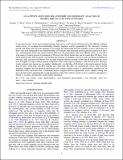| dc.contributor.author | West, Andrew A. | |
| dc.contributor.author | Weisenburger, Kolby L. | |
| dc.contributor.author | Irwin, Jonathan | |
| dc.contributor.author | Charbonneau, David | |
| dc.contributor.author | Dittmann, Jason | |
| dc.contributor.author | Pineda, J. Sebastian | |
| dc.contributor.author | Berta-Thompson, Zach | |
| dc.date.accessioned | 2015-11-24T20:35:49Z | |
| dc.date.available | 2015-11-24T20:35:49Z | |
| dc.date.issued | 2015-10 | |
| dc.date.submitted | 2015-02 | |
| dc.identifier.issn | 1538-4357 | |
| dc.identifier.issn | 0004-637X | |
| dc.identifier.uri | http://hdl.handle.net/1721.1/100048 | |
| dc.description.abstract | Using spectroscopic observations and photometric light curves of 238 nearby M dwarfs from the MEarth exoplanet transit survey, we examine the relationships between magnetic activity (quantified by Hα emission), rotation period, and stellar age. Previous attempts to investigate the relationship between magnetic activity and rotation in these stars were hampered by the limited number of M dwarfs with measured rotation periods (and the fact that v sin i measurements probe only rapid rotation). However, the photometric data from MEarth allows us to probe a wide range of rotation periods for hundreds of M dwarf stars (from shorter than one to longer than 100 days). Over all M spectral types that we probe, we find that the presence of magnetic activity is tied to rotation, including for late-type, fully convective M dwarfs. We also find evidence that the fraction of late-type M dwarfs that are active may be higher at longer rotation periods compared to their early-type counterparts, with several active, late-type, slowly rotating stars present in our sample. Additionally, we find that all M dwarfs with rotation periods shorter than 26 days (early-type; M1–M4) and 86 days (late-type; M5–M8) are magnetically active. This potential mismatch suggests that the physical mechanisms that connect stellar rotation to chromospheric heating may be different in fully convective stars. A kinematic analysis suggests that the magnetically active, rapidly rotating stars are consistent with a kinematically young population, while slow-rotators are less active or inactive and appear to belong to an older, dynamically heated stellar population. | en_US |
| dc.description.sponsorship | Torres Fellowship for Exoplanetary Research | en_US |
| dc.language.iso | en_US | |
| dc.publisher | IOP Publishing | en_US |
| dc.relation.isversionof | http://dx.doi.org/10.1088/0004-637X/812/1/3 | en_US |
| dc.rights | Article is made available in accordance with the publisher's policy and may be subject to US copyright law. Please refer to the publisher's site for terms of use. | en_US |
| dc.source | IOP Publishing | en_US |
| dc.title | AN ACTIVITY–ROTATION RELATIONSHIP AND KINEMATIC ANALYSIS OF NEARBY MID-TO-LATE-TYPE M DWARFS | en_US |
| dc.type | Article | en_US |
| dc.identifier.citation | West, Andrew A., Kolby L. Weisenburger, Jonathan Irwin, Zachory K. Berta-Thompson, David Charbonneau, Jason Dittmann, and J. Sebastian Pineda. “AN ACTIVITY–ROTATION RELATIONSHIP AND KINEMATIC ANALYSIS OF NEARBY MID-TO-LATE-TYPE M DWARFS.” The Astrophysical Journal 812, no. 1 (October 2, 2015): 3. © 2015 The American Astronomical Society | en_US |
| dc.contributor.department | MIT Kavli Institute for Astrophysics and Space Research | en_US |
| dc.contributor.mitauthor | Berta-Thompson, Zach | en_US |
| dc.relation.journal | The Astrophysical Journal | en_US |
| dc.eprint.version | Final published version | en_US |
| dc.type.uri | http://purl.org/eprint/type/JournalArticle | en_US |
| eprint.status | http://purl.org/eprint/status/PeerReviewed | en_US |
| dspace.orderedauthors | West, Andrew A.; Weisenburger, Kolby L.; Irwin, Jonathan; Berta-Thompson, Zachory K.; Charbonneau, David; Dittmann, Jason; Pineda, J. Sebastian | en_US |
| mit.license | PUBLISHER_POLICY | en_US |
| mit.metadata.status | Complete | |
